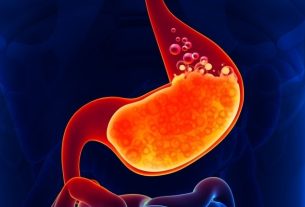The main symptom of a migraine is a throbbing headache that affects one side of the head, and may be accompanied by other symptoms such as nausea, vomiting and greater sensitivity to light or noise, directly interfering with the performance of daily activities.
In addition, visual changes may also occur, such as flashes of light and bright images, a tingling sensation or even difficulty moving parts of the body, which are generally temporary and are usually indicative of a migraine with aura. See more about migraine with aura.
If you suspect a migraine, it is important to consult a neurologist or general practitioner for an assessment and initiation of the most appropriate treatment, which may involve the use of analgesics and anticonvulsant medications, for example.

Main symptoms
The main symptoms of migraine are:
- Throbbing pain on only one side of the head;
- Nausea;
- Vomiting;
- Increased sensitivity to light;
- Uncomfortable in noisy environments;
- Inability to make efforts;
- Sensitivity to certain smells, such as perfumes or cigarette smell;
- Difficulty concentrating;
- Dizziness.
In some cases, symptoms such as mood changes, restlessness, increased desire for certain foods and difficulty seeing may occur approximately 24 to 48 hours before the migraine attack.
Furthermore, in the case of migraine with aura, other symptoms, such as seeing lights, loss of vision and tingling throughout the body, can also occur before or during the pain attack and tend to improve in less than 1 hour.
Online symptom test
To find out if you have a migraine, please select the symptoms you are experiencing:
This test is only a guidance tool and, therefore, is not intended to provide a diagnosis or replace consultation with a neurologist or general practitioner.
How to know if it’s a headache or a migraine
To differentiate migraines from other types of headaches, it is important to consult a neurologist or general practitioner, who generally takes into account the physical examination and the symptoms presented to confirm the diagnosis.
Unlike other headaches, migraine pain is throbbing, occurs only on one side of the head, worsens with exertion or movement and is usually accompanied by other symptoms such as nausea, vomiting, increased sensitivity to light or noise.
However, in some cases the doctor may recommend tests such as computed tomography or magnetic resonance imaging to rule out the possibility of more serious causes of headache, such as tumors and aneurysms, for example.
Make an appointment with the nearest neurologist to evaluate your headache and begin the most appropriate treatment:
Taking care of your health has never been easier!
What causes migraines
Migraines can be caused by hormonal changes, such as menstruation or pregnancy, stress, poor diet, sleeping too much or too little, for example.
Furthermore, in some cases a migraine attack can occur after drinking drinks such as wine or coffee and foods such as chocolate, cheese, ice cream or nuts. Find out the main causes of migraines and what to do.
Read too: Throbbing headache: 7 causes, symptoms (and what to do)
Who is most at risk for migraines
The causes of migraines are not yet fully known, however, migraines tend to be more common in women and may occur due to hormonal changes in the menstrual cycle.
Additionally, people who experience periods of high stress or who are having difficulty sleeping are also at greater risk of having a migraine attack. Other factors such as the use of some medications, eating processed food or changes in the weather can also increase the chances of developing a crisis.
How the treatment is carried out
Migraine treatment generally involves medications to relieve pain in the event of an attack, such as paracetamol, ibuprofen and zolmitriptan, and medications to prevent new attacks from occurring, such as propranolol and topiramate, and should only be used with a doctor’s advice. Better understand the treatment options for migraines.
Furthermore, it is important to learn to recognize the symptoms that normally precede a migraine attack, such as feeling unwell, pain in the back of the neck or sensitivity to light, smell or noise, so that treatment can be started as soon as possible.
Bibliography
- STATPEARLS. Migraine Headache. 2022. Available at: <https://www.ncbi.nlm.nih.gov/books/NBK560787/>. Accessed on September 23, 2022
- BURCH, Rebecca. Migraine and Tension-Type Headache: Diagnosis and Treatment. . . . North Am Clin Med. Vol.103, n.2. 215-233,
- GAZERANI, Paris. Migraine and Diet. Nutrients. Vol.12, n.6. 1658, 2020
- LONGO, Dan L. et al. Harrison Internal Medicine. 18.ed. São Paulo: AMGH Editora, 2013. 114-120.
- AMERICAN MIGRAINE FOUNDATION. Common Types of Migraine and Related Symptoms. Disponível em: <https://americanmigrainefoundation.org/resource-library/migraine-related-symptoms/>. Acesso em 23 jul 2020
- NHS. Migraine: symptoms. Available at: <https://www.nhs.uk/conditions/migraine/symptoms/>. Accessed on 23 Jul 2020
- MELADO, Eliana Meire. Headache and migraine: everything you need to know!. Rio de Janeiro: Atheneu, 2017. 31-33.

Sign up for our newsletter and stay up to date with exclusive news
that can transform your routine!
Warning: Undefined array key "title" in /home/storelat/public_html/wp-content/plugins/link-whisper-premium/templates/frontend/related-posts.php on line 12
Warning: Undefined array key "title_tag" in /home/storelat/public_html/wp-content/plugins/link-whisper-premium/templates/frontend/related-posts.php on line 13



